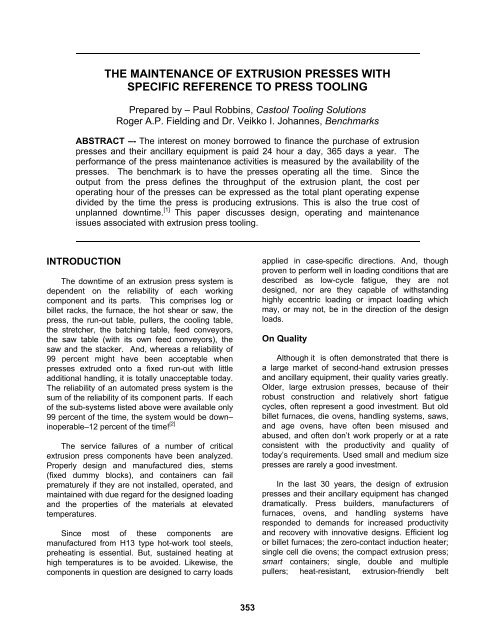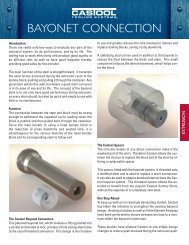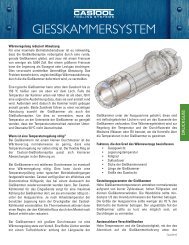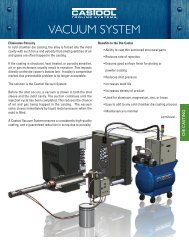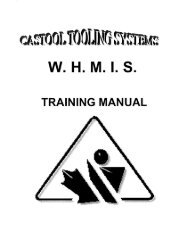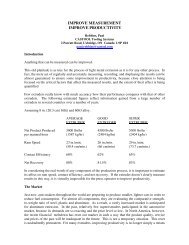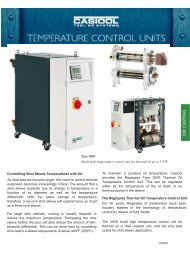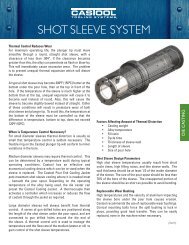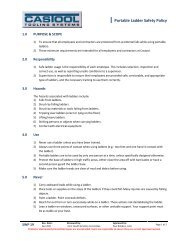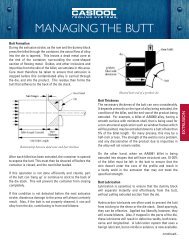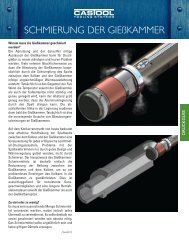the maintenance of extrusion presses with specific reference to ...
the maintenance of extrusion presses with specific reference to ...
the maintenance of extrusion presses with specific reference to ...
You also want an ePaper? Increase the reach of your titles
YUMPU automatically turns print PDFs into web optimized ePapers that Google loves.
handling systems; semi-au<strong>to</strong>matic and au<strong>to</strong>maticstretchers; and saws and stacking systems havereplaced many <strong>of</strong> <strong>the</strong> older, manually operatedequipment. In <strong>the</strong> intervening years, competitiveand economic pressures have resulted in <strong>the</strong> reengineering<strong>of</strong> many features <strong>of</strong> <strong>the</strong> equipment, and<strong>the</strong> resulting changes have not always been <strong>to</strong> <strong>the</strong>good <strong>of</strong> its operation or its economic life.Manufacturing machinery is purchased on <strong>the</strong>assumption that it is “fit for purpose,” and that it willdeliver product at <strong>the</strong> required output and quality.The <strong>specific</strong>ation <strong>of</strong> any new (or used) piece <strong>of</strong>equipment will always include <strong>the</strong> acceptancestandards that set out <strong>the</strong> teats <strong>to</strong> be met beforefinal payment is made. An analysis <strong>of</strong> competitivebids will also include a comparison <strong>of</strong> <strong>the</strong> weight <strong>of</strong>proposed equipmentBefore any discussion <strong>of</strong> why <strong>to</strong>oling fails, it isappropriate <strong>to</strong> refer <strong>to</strong> John Ruskin’s (1829-1900)<strong>of</strong>ten-quoted description <strong>of</strong> “quality”:Quality: <strong>the</strong>re is hardly anything in <strong>the</strong> worldthat some men cannot make a little worse,and sell a little cheaper; and <strong>the</strong> people whoconsider price only are this man’s lawfulprey. It’s unwise <strong>to</strong> pay <strong>to</strong>o much, but it’sworse <strong>to</strong> pay <strong>to</strong>o little. When you pay <strong>to</strong>omuch you lose a little money, that is all.When you pay <strong>to</strong>o little you sometime loseeverything, because <strong>the</strong> thing you boughtwas incapable <strong>of</strong> doing <strong>the</strong> thing you boughtit <strong>to</strong> do. The common law <strong>of</strong> businessbalance prohibits paying a little and getting alot – it can’t be done. If you deal <strong>with</strong> <strong>the</strong>lowest bidder, it’s as well <strong>to</strong> add somethingfor <strong>the</strong> risk you take. And if you do that, youwill have enough <strong>to</strong> pay for somethingbetter.An examination <strong>of</strong> <strong>the</strong> failure <strong>of</strong> returned <strong>to</strong>olingand ancillary equipment reveals numerousexamples where <strong>the</strong> desire <strong>to</strong> reduce <strong>the</strong> up-frontcost <strong>of</strong> <strong>to</strong>oling has resulted in poor, and, in somecases, plain “wrong” engineering design.HOW TO MAINTAIN EXTRUSIONPRESSESThe press systems described in <strong>the</strong> introductionare a combination <strong>of</strong> many components operating inunison. Whereas earlier <strong>presses</strong> operated <strong>with</strong>separate, discrete sub-systems including furnaces,run-out, handling, stretcher, and saws <strong>the</strong>rebyallowing for some operation in <strong>the</strong> case <strong>of</strong>breakdown or adjustment, <strong>the</strong> overall reliability <strong>of</strong><strong>the</strong> modern system is no better than <strong>the</strong> reliability <strong>of</strong><strong>the</strong> weakest link.In recent years, <strong>extrusion</strong> press systems havebecome more reliable through <strong>the</strong> use <strong>of</strong>programmable logic controllers and sophisticateddiagnostic s<strong>of</strong>tware programs. Improvements <strong>to</strong> <strong>the</strong>engineering <strong>of</strong> components such as belts,couplings, valves, and micro-switches haveincreased <strong>the</strong> mean time between failures (MTBF)<strong>of</strong> <strong>the</strong>se components. The development <strong>of</strong> noncontactposition sensing devices has removedsome components from <strong>the</strong> system. Understanding<strong>of</strong> <strong>the</strong> mechanisms <strong>of</strong> wear has resulted in <strong>the</strong>development and use <strong>of</strong> new lubricants, andincreasingly stringent requirements for <strong>the</strong> control <strong>of</strong>cleanliness and temperature <strong>of</strong> hydraulic fluids.The combination <strong>of</strong> <strong>the</strong>se developments hasimproved inherent reliability and has permitted <strong>the</strong>introduction and development <strong>of</strong> au<strong>to</strong>mated<strong>extrusion</strong> press systems. The downtime <strong>of</strong> asystem <strong>of</strong> log or billet racks, furnace, hot shear,press and run out, pullers, cooling table, stretcher,batching table and feed conveyors, saw table (<strong>with</strong>its feed conveyors), saw and stacker will, as waspointed out earlier, be dependent on <strong>the</strong> reliability <strong>of</strong>each <strong>of</strong> <strong>the</strong> component working parts.In planning <strong>to</strong> improve reliability, <strong>the</strong> design and<strong>maintenance</strong> engineers must consider <strong>the</strong> inherentreliability <strong>of</strong> each part, <strong>the</strong> probable mean timebetween failure <strong>of</strong> each part, <strong>the</strong> number <strong>of</strong> workingparts, and <strong>the</strong> time taken <strong>to</strong> fix a problem. Aproblem that only takes a few seconds <strong>to</strong> correct isnot much <strong>of</strong> a problem if it occurs infrequently. But ifit recurs <strong>with</strong> every billet pushed (as <strong>with</strong> a billetloader that must be manually assisted, a buttdiscard that fails <strong>to</strong> separate from <strong>the</strong> shear, orspacers that do not feed consistently <strong>to</strong> <strong>the</strong> stacker)it will require <strong>the</strong> undivided attention <strong>of</strong> an opera<strong>to</strong>rat some time during each working cycle. Again, <strong>the</strong>reliability <strong>of</strong> <strong>the</strong> system is a function <strong>of</strong> <strong>the</strong> reliability<strong>of</strong> <strong>the</strong> sub-systems.Press AlignmentThe alignment <strong>of</strong> press components must bekept <strong>with</strong>in tight <strong>to</strong>lerances. Improper alignment isone <strong>of</strong> <strong>the</strong> causes <strong>of</strong> inconsistent die performance;it causes premature failure <strong>of</strong> fixed dummy blocks
and, in extreme cases, damage or breakage <strong>to</strong>stems, containers, and tie rods.Modern, self-contained <strong>extrusion</strong> <strong>presses</strong> areconstructed <strong>with</strong> a fabricated steel base extending<strong>the</strong> full length <strong>of</strong> <strong>the</strong> press. The rear platen is fixed<strong>to</strong> <strong>the</strong> fabricated base. The front platen, connected<strong>to</strong> <strong>the</strong> rear platen by <strong>the</strong> tie rods, is keyed <strong>to</strong> <strong>the</strong>base, but free <strong>to</strong> slide forward and backwardsduring each stroke <strong>of</strong> <strong>the</strong> press. Older <strong>presses</strong>,which are <strong>of</strong>ten constructed <strong>with</strong>out <strong>the</strong> fabricatedbase, have separate foundations for rear and frontplatens.The base (and foundation) must be level and ingood condition, and <strong>the</strong> stem and container mustmove parallel <strong>to</strong> <strong>the</strong> base throughout <strong>the</strong> pressstroke. Optical (laser) instruments are used for<strong>the</strong>se measurements.Although it is <strong>of</strong>ten assumed that <strong>the</strong>re hasbeen no change <strong>to</strong> <strong>the</strong> original symmetry <strong>of</strong> <strong>the</strong>columns <strong>with</strong> respect <strong>to</strong> <strong>the</strong> center-lines <strong>of</strong> <strong>the</strong>platens, it is believed that alignment should start<strong>with</strong> confirming <strong>the</strong> condition <strong>of</strong> <strong>the</strong> guide-ways,(including that <strong>of</strong> <strong>the</strong> front platen), <strong>the</strong> stem and diepressure plates; and <strong>the</strong> relative position <strong>of</strong> frontand rear platens, <strong>the</strong> stem and <strong>the</strong> container <strong>with</strong><strong>the</strong> ram in <strong>the</strong> forward and back positions.A complete alignment <strong>the</strong>n starts <strong>with</strong> <strong>the</strong>platens―<strong>with</strong> pre-stressing <strong>of</strong> <strong>the</strong> tie rods―andproceeds <strong>to</strong> <strong>the</strong> main ram, stem, container, dieslide, shear, and billet loader.Alignment can be continuously moni<strong>to</strong>red, but isusually checked by press crew using <strong>the</strong> impression<strong>of</strong> <strong>the</strong> fixed dummy block on card, which is placedbetween <strong>the</strong> block and <strong>the</strong> die face, by checkingbutt discards, or by <strong>the</strong> use <strong>of</strong> an alignment stack. [3]InspectionThere is no substitute for regular inspection.The press ways must be inspected for signs <strong>of</strong>uneven wear. The stem, <strong>the</strong> fixed dummy block, <strong>the</strong>butt discard, <strong>the</strong> container faces, and <strong>the</strong> shear areinspected for evidence <strong>of</strong> misalignment.As <strong>the</strong> press goes through its cycle, <strong>the</strong>inspec<strong>to</strong>r must look for uneven or hesitant motionsas <strong>the</strong>y occur and note <strong>the</strong>ir possible origins (whichcould even be a misalignment <strong>of</strong> <strong>the</strong> shear blade,pressure plate, or inadequate control <strong>of</strong> die stackdimensions). Strain gauges that are fixed <strong>to</strong> <strong>the</strong>press columns can moni<strong>to</strong>r <strong>the</strong> loads on <strong>the</strong> pressand provide early warning <strong>of</strong> uneven loading. Inaddition, <strong>the</strong>y are sensitive enough <strong>to</strong> indicatehesitation in <strong>the</strong> motion <strong>of</strong> <strong>the</strong> container, die slide,or shear.Attention <strong>to</strong> lubrication <strong>of</strong> press ways willminimize wear, but lubrication applied elsewhere isdetrimental <strong>to</strong> <strong>the</strong> <strong>extrusion</strong> process. Understandthat lubrication <strong>of</strong> <strong>the</strong> fixed dummy block, <strong>the</strong> shearblade, <strong>the</strong> face <strong>of</strong> <strong>the</strong> container, and <strong>the</strong> die stackshould be kept <strong>to</strong> an absolute minimum. Lubricating<strong>the</strong> face, or worse, <strong>the</strong> periphery <strong>of</strong> <strong>the</strong> fixeddummy block, risks introducing lubricants in<strong>to</strong> <strong>the</strong>container, <strong>with</strong> <strong>the</strong> attendant risk <strong>to</strong> product quality.Lubricants can be carried through <strong>to</strong> <strong>the</strong> longitudinalwelds <strong>of</strong> hollow aluminum sections. They will alsobe entrained in <strong>the</strong> transverse welds in solid andhollow sections causing welds <strong>to</strong> fail duringstretching or in service.Excessive lubrication is sometimes justified asa means <strong>of</strong> extending <strong>the</strong> life <strong>of</strong> <strong>the</strong> fixed dummyblock. The moving surfaces <strong>of</strong> <strong>the</strong> fixed dummyshould be lubricated <strong>with</strong> high-pressure lubricantbefore assembly. But, any lubrication, which isnecessary <strong>to</strong> enable <strong>the</strong> butt <strong>to</strong> separate from <strong>the</strong>face <strong>of</strong> <strong>the</strong> dummy block, is best applied <strong>to</strong> <strong>the</strong> billetbefore <strong>the</strong> billet heater or, in <strong>the</strong> case <strong>of</strong> a hot logshear, between <strong>the</strong> shear and <strong>the</strong> press.Excessive lubrication <strong>of</strong> <strong>the</strong> shear blade or <strong>the</strong>face <strong>of</strong> <strong>the</strong> container suggests that <strong>the</strong> bladeclearances are not correct; this in turn suggests that<strong>the</strong> length <strong>of</strong> <strong>the</strong> die stack is not precisely controlledor <strong>the</strong> die stack is not seated properly. “Show <strong>the</strong>shear blade <strong>the</strong> lubricant, and wipe it <strong>of</strong>f.” [4]The development <strong>of</strong> lubricants that contain nographite or petroleum-based products has removedmany <strong>of</strong> <strong>the</strong> risks associated <strong>with</strong> <strong>the</strong> use <strong>of</strong>hydrocarbons in high temperature, high-pressureenvironments. Fur<strong>the</strong>rmore, <strong>the</strong> use <strong>of</strong> benignlubricants, such as boron nitride, appears <strong>to</strong>minimize or eliminate problems that can occur whenhydrocarbons or <strong>the</strong>ir residues enter <strong>the</strong>longitudinal welds in hollow sections. Boron nitride(BN) can be applied <strong>to</strong> <strong>the</strong> back-end face <strong>of</strong> <strong>the</strong>heated billet, <strong>to</strong> <strong>the</strong> internals <strong>of</strong> <strong>the</strong> fixed dummyblock, and <strong>to</strong> <strong>the</strong> butt shear.Extrusion DiesExtrusion dies, particularly hollow <strong>extrusion</strong>dies, will fail if <strong>the</strong>y are not properly supported. The
platen ring, <strong>the</strong> sub-bolsters, and bolsters must beflat, round and <strong>the</strong> faces must be square. Few, ifany, first class extruders still use common diebackers due <strong>to</strong> <strong>the</strong>ir deleterious effects on <strong>the</strong>performance <strong>of</strong> <strong>the</strong> <strong>extrusion</strong> die. But bolsters andsub-bolsters are usually common <strong>to</strong> a number <strong>of</strong>hollow and solid dies. Support <strong>to</strong>oling―commonbackers, bolsters and sub-bolsters, and <strong>the</strong>pressure ring―will dis<strong>to</strong>rt <strong>with</strong> time. The flatness <strong>of</strong><strong>the</strong> working surfaces must be moni<strong>to</strong>red; dis<strong>to</strong>rtedand dished <strong>to</strong>oling must be replaced. On <strong>presses</strong>equipped <strong>with</strong> in-line quench systems, particularcare must be taken <strong>to</strong> moni<strong>to</strong>r <strong>the</strong> condition <strong>of</strong> <strong>the</strong>pressure ring due <strong>to</strong> <strong>the</strong> possibility <strong>of</strong> corrosionbetween <strong>the</strong> ring and <strong>the</strong> platen.Extrusion dies can break and fail <strong>to</strong> run properlyif <strong>the</strong>y are not heated <strong>to</strong> <strong>the</strong> correct operatingtemperature. The die should be heated as quicklyas possible, <strong>with</strong>out overheating <strong>the</strong> surface, andheld at temperature no longer than is necessary <strong>to</strong>accommodate <strong>the</strong> production schedule. Properlydesigned and constructed single cell die ovensensure that <strong>extrusion</strong> dies reach <strong>the</strong> correct,uniform, temperature in minimum time. Visualmanagement systems will ensure that <strong>the</strong> correctdie is delivered <strong>to</strong> <strong>the</strong> <strong>extrusion</strong> press just in time.Figure 2. The heated die slideThe electrical heating systems must be properlycontrolled and sustained. Maintenance <strong>of</strong> <strong>the</strong>correct operating temperature for all die stackcomponents ensures that dies run properly from <strong>the</strong>first billet and that productivity and recovery ismaximized.Press ContainerThe press container is <strong>the</strong> most expensive item<strong>of</strong> press <strong>to</strong>oling, and its design has evolved <strong>with</strong>time. However, it is evident that some designs,presumably <strong>to</strong> reduce <strong>the</strong> cost <strong>of</strong> manufacture,have introduced features that weaken <strong>the</strong>mechanical structure and promote prematurefailure.Figure 1. Die oven development, showing aninstrumented die being moni<strong>to</strong>red <strong>to</strong> ensure tha<strong>to</strong>verheating cannot occur in serviceThe merits <strong>of</strong> heating support <strong>to</strong>oling are wellunders<strong>to</strong>od, but, although some extruders pre-heat<strong>the</strong> bolster, few extruders use bolsters <strong>with</strong> integralheating systems. In most applications, preheating<strong>the</strong> bolster will improve <strong>the</strong> performance <strong>of</strong> <strong>the</strong><strong>extrusion</strong> die. However, electrically heated bolsters,die slides, and ram-noses (for indirect <strong>extrusion</strong>)are increasingly being used <strong>to</strong> maintain <strong>the</strong> correct<strong>the</strong>rmal gradients during <strong>extrusion</strong> operations.Figure 3. Introduction <strong>of</strong> a keyway, as opposed <strong>to</strong><strong>the</strong> use <strong>of</strong> an external bolt-on key, introduces astress raiser and, in effect, makes <strong>the</strong> outer surface<strong>of</strong> <strong>the</strong> container a redundant structural elementThe basic principles <strong>of</strong> designing thick-walledcylinders subjected <strong>to</strong> internal pressure are set outin many texts. For example, Extrusion [5] , by Laue
and Stenger, explains how using multiple layersconsisting <strong>of</strong> a liner, sub-liner, and mantle canstreng<strong>the</strong>n <strong>the</strong> container structure. It also explainshow <strong>the</strong> resulting assembly is weakened by <strong>the</strong>improper placement <strong>of</strong> heating elements.The press container has <strong>to</strong> be preheated prior<strong>to</strong> <strong>extrusion</strong>. However, poorly controlled wraparoundheating systems are known <strong>to</strong> be <strong>the</strong> cause<strong>of</strong> premature failure since <strong>the</strong>y can s<strong>of</strong>ten <strong>the</strong> outermantle.The wrap-around heaters are being replaced bymulti-functional heating elements inserted in holesin <strong>the</strong> container. In addition, can heaters, which areinserted in<strong>to</strong> <strong>the</strong> bore <strong>of</strong> <strong>the</strong> container, are used forpreheating and maintaining <strong>the</strong> temperaturegradients.Containers and <strong>the</strong>ir <strong>the</strong>rmal control systemsmust be inspected <strong>to</strong> ensure that <strong>the</strong> liner remainsin good condition, that <strong>the</strong> mantle is strong enough<strong>to</strong> support <strong>the</strong> liner under pressure, and that <strong>the</strong>heaters and <strong>the</strong>rmocouples are working asdesigned.fixed dummy block, so that <strong>the</strong> maximum unitpressure on <strong>the</strong> stem is higher than that on <strong>the</strong> face<strong>of</strong> <strong>the</strong> dummy block. The stem is designed <strong>to</strong> beuniformly loaded. Eccentric loading, which canoccur for a number <strong>of</strong> reasons, may result in <strong>the</strong>stem bending or breaking. Improper pressalignment (<strong>the</strong> result <strong>of</strong> inadequate inspection and<strong>maintenance</strong> procedures), a hanging buttpreventing proper sealing <strong>of</strong> <strong>the</strong> container, or, forexample, poorly cut billet can result in eccentricloading.Because it is highly stressed, <strong>the</strong> surface <strong>of</strong> <strong>the</strong>stem must be kept free <strong>of</strong> surface defects. Improperhandling <strong>of</strong> <strong>the</strong> stem, accidental mechanicaldamage or rapid heating or cooling <strong>of</strong> <strong>the</strong> surfacefrom direct flame impingement or stray water mustbe avoided. The surface <strong>of</strong> <strong>the</strong> stem must be free <strong>of</strong>stress-raisers; <strong>the</strong> stem should periodically bestress-relieved.Table 1. Recommended Practices for StressRelieving StemsThe Fixed Dummy BlockFigure 4. A container that has been overheatedThe Press StemThe press stem (ram) must be properly installedon an inspected and maintained pressure ring. Thestem should be heated prior <strong>to</strong> use by advancing itin<strong>to</strong> <strong>the</strong> hot container.The alignment should be periodically checked<strong>to</strong> ensure that <strong>the</strong> stem is concentric <strong>to</strong> <strong>the</strong>container bore throughout its stroke. The diameter<strong>of</strong> <strong>the</strong> stem is smaller than <strong>the</strong> container bore, and<strong>the</strong> face <strong>of</strong> <strong>the</strong> stem is usually designed <strong>to</strong> carry aFixed dummy blocks must be properly sized for<strong>the</strong> press and aluminum alloy being extruded, and<strong>the</strong>y should expand and contract a fixed amount oneach pressure stroke. Single cell ovens should beused <strong>to</strong> preheat <strong>the</strong> fixed dummy block, and, whilein service, <strong>the</strong> dummy block can be kept attemperature by advancing <strong>the</strong> press ram <strong>to</strong> bring<strong>the</strong> dummy block in<strong>to</strong> <strong>the</strong> container whenever <strong>the</strong>press is s<strong>to</strong>pped.The fixed dummy block should be inspecteddaily. It should be visually checked for aluminumbuild up on <strong>the</strong> face and <strong>the</strong> land. The land shouldalso be checked for evidence <strong>of</strong> explosions. Themandrel should be free and forward from <strong>the</strong> face <strong>of</strong><strong>the</strong> dummy block.Once each week, <strong>the</strong> dummy block should beremoved from <strong>the</strong> press and cleaned in caustic. Itshould be visually inspected for signs <strong>of</strong> wear, and
measured accurately across <strong>the</strong> face. Thedimension should be recorded and compared <strong>to</strong> <strong>the</strong>diameter <strong>of</strong> <strong>the</strong> block when it was new, since <strong>the</strong>dummy block will eventually grow <strong>to</strong> take up apermanent set.from <strong>the</strong> <strong>extrusion</strong> die face. Hard alloys are typicallysheared using a blunt or block shear.As <strong>the</strong> diameter <strong>of</strong> <strong>the</strong> dummy block increases,blisters will form on <strong>the</strong> <strong>extrusion</strong>. Machining <strong>the</strong>land <strong>to</strong> <strong>the</strong> original diameter can prevent <strong>the</strong>seblisters and extend <strong>the</strong> dummy block’s life.Figure 6. The butt shearPress MaintenanceFigure 5. Fixed dummy block in good condition ona 2500 <strong>to</strong>n pressAll <strong>the</strong> components mentioned above must bemechanically and <strong>the</strong>rmally aligned at all times.The Butt ShearThe butt contains <strong>the</strong> surface skin <strong>of</strong> <strong>the</strong> billetthat has flowed inwards and across <strong>the</strong> face <strong>of</strong> anadvancing dummy block. At <strong>the</strong> end <strong>of</strong> each pressstroke <strong>the</strong> butt must be discarded. With <strong>the</strong>container open, and <strong>the</strong> stem and dummy blockinside <strong>the</strong> container, <strong>the</strong> butt, which is still attached<strong>to</strong> <strong>the</strong> back <strong>of</strong> <strong>the</strong> die, is exposed, ready forremoval.Modern <strong>extrusion</strong> <strong>presses</strong> are equipped <strong>to</strong>position <strong>the</strong> butt so <strong>the</strong>re is about a 0.020-inch(0.51mm) gap between <strong>the</strong> die face and <strong>the</strong> path <strong>of</strong><strong>the</strong> shear blade. Older <strong>presses</strong> must be maintainedso that <strong>the</strong> relative position <strong>of</strong> die face and shearblade retain this clearance.The design <strong>of</strong> <strong>the</strong> shear blade varies <strong>with</strong> <strong>the</strong>size <strong>of</strong> <strong>the</strong> <strong>extrusion</strong> press and <strong>the</strong> alloy beingsheared. Common alloys, <strong>with</strong> smooth as-castsurfaces and little shell zone, can be extruded down<strong>to</strong> a very thin butt. This butt must literally be peeledThe press system must be maintained <strong>to</strong> meetits performance capability. The billet furnace mustdeliver <strong>the</strong> billet at <strong>the</strong> specified temperatures. Thepress must be correctly aligned. Pressures, speeds,and clearances must be maintained <strong>to</strong> eliminate <strong>the</strong>creation <strong>of</strong> mushrooms and flashes, and <strong>to</strong> ensurethat <strong>the</strong> butt shear cuts cleanly, and <strong>the</strong> fixeddummy block operates properly. The equipmentmust be available for operation at all times.Making equipment available for use requires anunderstanding <strong>of</strong> why it breaks down.Understanding why machinery does not workcomes from taking appropriate measurements andan intimate knowledge <strong>of</strong> machine design.SUMMARYExtrusion dies–hollow and solid–break when<strong>the</strong> load, and hence <strong>the</strong> stress in <strong>the</strong> H13 <strong>to</strong>ol steel,exceeds its ultimate strength. Although thousands<strong>of</strong> <strong>extrusion</strong> dies are put in<strong>to</strong> use every workingday, die breakage is extremely rare. Breakages areusually limited <strong>to</strong> details that are difficult <strong>to</strong> support.However, H13 is a hot-work <strong>to</strong>ol steel and must bepreheated prior <strong>to</strong> its use. Improper preheating intraditional chest ovens, where continual loading andunloading <strong>of</strong> dies disrupts <strong>the</strong> intended heatingcycle resulting in cold dies being loaded in<strong>to</strong> <strong>the</strong><strong>extrusion</strong> press, has been shown <strong>to</strong> be one <strong>of</strong> <strong>the</strong>causes <strong>of</strong> premature failure. Whereas <strong>to</strong>o low atemperature can result in breakage, dietemperature that is <strong>to</strong>o high can result in prematurefailure because <strong>of</strong> excessive wear.
The press stem, although not in <strong>the</strong> true sense<strong>of</strong> <strong>the</strong> term structural column, has <strong>to</strong> <strong>with</strong>stand highcompressive stresses. Although on many <strong>extrusion</strong><strong>presses</strong>, <strong>the</strong> unit pressure will not exceed 80,000pounds per square inch, modern high-performance<strong>presses</strong> consistently operate <strong>with</strong> a unit pressure inexcess <strong>of</strong> 110,000 pounds per square inch. Thefixed dummy block is designed <strong>to</strong> ensure that <strong>the</strong>loads are not concentrated.Because <strong>of</strong> <strong>the</strong> high unit pressure, <strong>the</strong> staticalignment <strong>of</strong> <strong>the</strong> press stem, container, and <strong>the</strong> diestack must be maintained <strong>with</strong>in close <strong>to</strong>leranceduring <strong>the</strong> operation <strong>of</strong> <strong>the</strong> <strong>extrusion</strong> press. Thisensures that <strong>the</strong> load on <strong>the</strong> stem remains axial <strong>to</strong><strong>the</strong> stem.REFERENCES1. Goldratt, Eliyahu M., The Goal: A process<strong>of</strong> Ongoing Improvement, Revised Edition,North River Press, Cro<strong>to</strong>n-on-Hudson,1986.2. Fielding, Roger A. P., "The Maintenance <strong>of</strong>Extrusion plant: Operating ExtrusionPresses for Maximum Efficiency," SixthInternational Extrusion TechnologySeminar, ET’96, Chicago 1996, Vol. I, 275-280.3. Robbins, Paul, “Dummy Blocks, Clean OutBlocks, Lubrication and Film Coatings, andAlignment (The Enemy),” AluminumExtruders Council Preventive MaintenanceWorkshop, April 24-26.4. Hains, R. W., Unpublished internal report1989.5. Laue, K., and H. Stenger, Extrusion,originally published in German asStrangpressen, Aluminium-Verlag GmbH,Duseldorf, 1976, American Society forMetals, Metals Park, Ohio, 1981.


